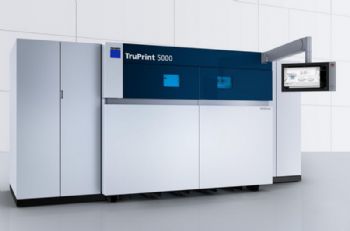
Trumpf (
www.trumpf.com) recently demonstrated how a TruPrint 5000 metal 3-D printer —pre-heated to 500°C — can print high-carbon steel or titanium alloy components that do not crack or severely warp.
Tobias Baur, Trumpf general manager (additive manufacturing), said: “Tool and mould makers can now easily print forming tools, punches and dies. Previously, without pre-heating, that was not possible.
Tool and mould makers frequently work with carbon tool steel 1.2343, an extremely hard and wear-resistant material that dissipates heat particularly well. To date, however, this material could not be processed in 3-D printers, because the components cracked during printing.
“The laser beam melts the component surface, which subsequently cools down to room temperature, but the components weren’t able to withstand this temperature drop, and cracks formed.
"However, by enabling the substrate plate of the TruPrint 5000 3-D printer to be pre-heated to 500°C, the temperature drop following laser melting is controlled and component fracturing is prevented.
“Pre-heating also offers major advantages for prostheses and implants produced using additive manufacturing, eliminating warpage and subsequent reworking.
"Pre-heating the TruPrint 5000 not only reduces stresses while improving processing quality but in many cases also eliminates the need for support structures.
"Pre-heating often reduces the need for downstream heat treatment, as well as making the titanium more resilient and the implants more durable.”
In another application, Trumpf used a green laser with pulse function to demonstrate the printing of pure copper and other precious metals by connecting a TruDisk 1020 disk laser with a TruPrint 1000 3-D printer.
Trumpf’s AM manager, Thomas Fehn, said: “Conventional systems use an infra-red laser as the beam source, but its wavelength is too long and it cannot weld highly reflective materials such as copper and gold.
"This can be done with laser light in the green wavelength spectrum, and it is particularly useful in the jewellery industry, as the 3-D printer doesn’t waste costly gold and silver.”